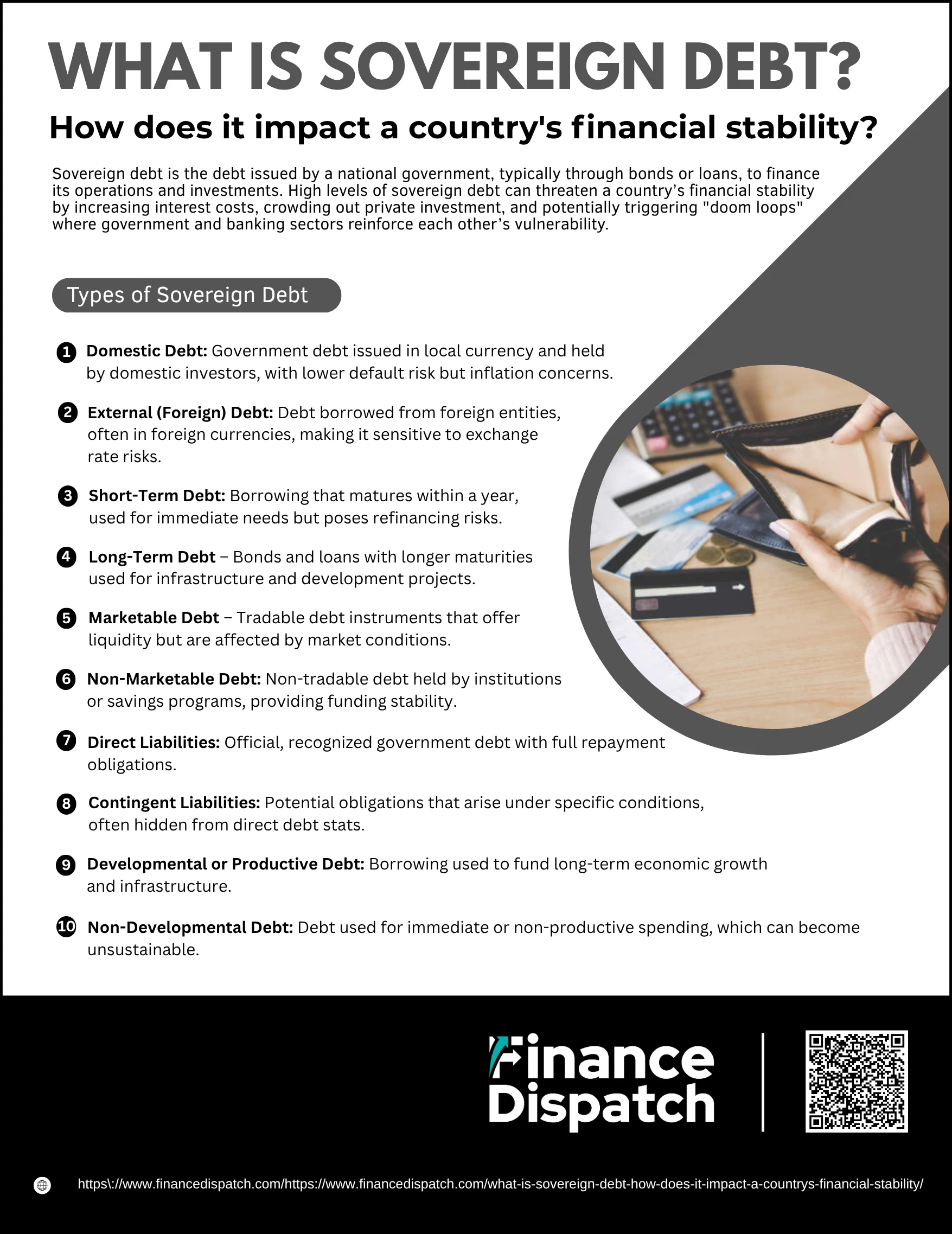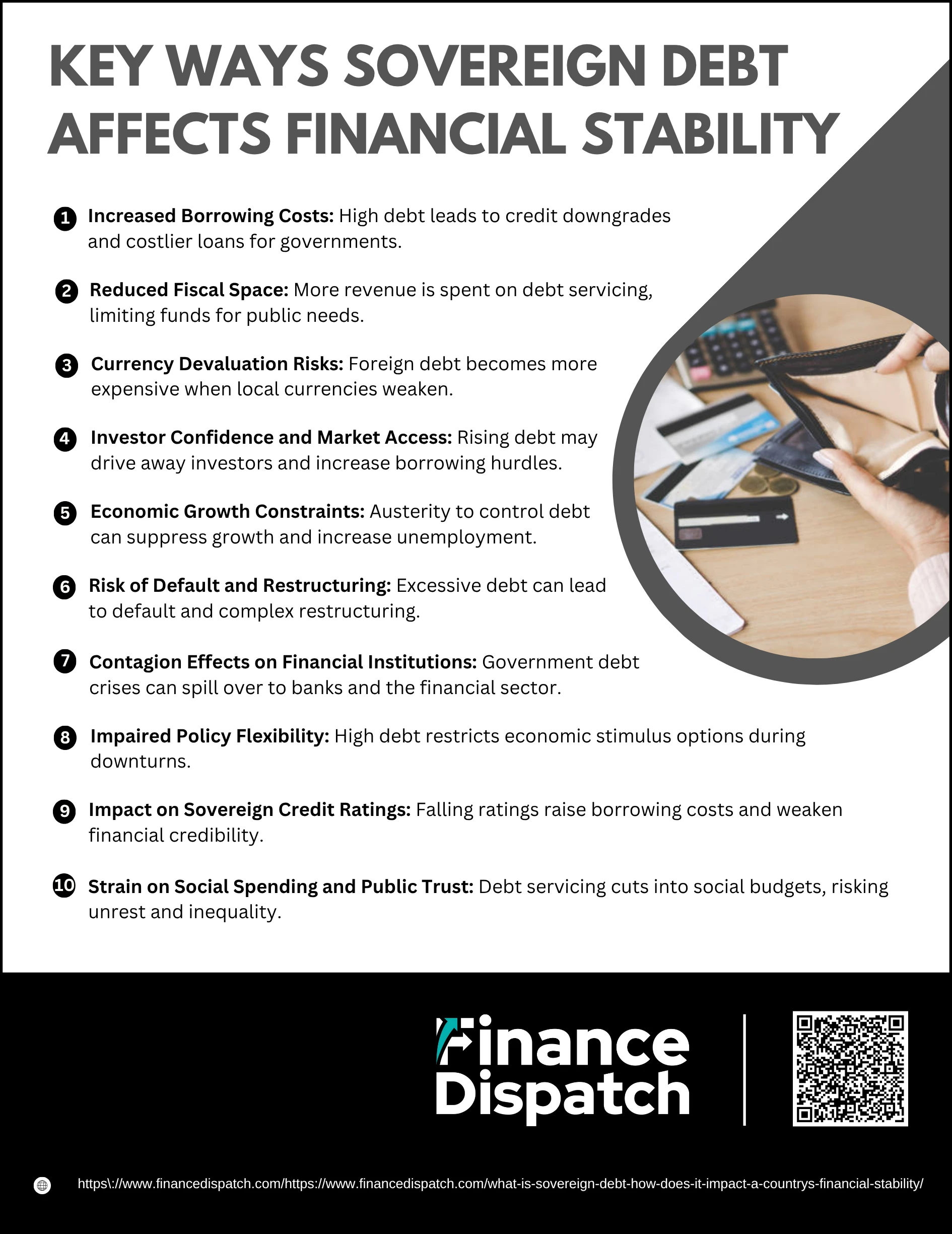Sovereign debt, often referred to as government or national debt, is the money a country’s central government owes to creditors—ranging from domestic investors and institutions to foreign governments and international organizations. While borrowing is a common tool used by governments to fund infrastructure projects, social programs, and crisis management, the accumulation of sovereign debt carries significant economic consequences. When managed wisely, it can stimulate growth and stability; however, excessive or mismanaged debt can trigger financial distress, inflation, or even default. As global public debt reaches historic highs, understanding what sovereign debt is and how it influences a nation’s financial stability is more important than ever. This article explores the fundamentals of sovereign debt, why countries borrow, who lends them money, and the critical impact this debt can have on a country’s economic health.
What is Sovereign Debt?
Sovereign debt refers to the total amount of money that a country’s national government owes to its creditors. It is typically raised by issuing debt instruments such as bonds, treasury bills, and loans, either in the domestic market or from international sources. This debt can be held by private investors, financial institutions, foreign governments, or multilateral organizations like the International Monetary Fund (IMF) and the World Bank. Sovereign debt is used to finance budget deficits when government expenditures exceed revenues from taxes and other income sources. While the liability technically rests with the government, the burden of repayment often impacts the nation’s citizens through taxation or reduced public services. Sovereign debt may be denominated in the country’s own currency or in foreign currencies, with the latter often posing greater risks due to exchange rate fluctuations.
 Types of Sovereign Debt
Types of Sovereign Debt
Sovereign debt encompasses a wide range of borrowing instruments and classifications, each with its own implications for economic strategy, repayment risk, and policy flexibility. By breaking down sovereign debt into distinct types—based on source, maturity, tradability, and purpose—we gain a clearer understanding of how governments manage their public finances and the risks they undertake. The following are the main types of sovereign debt, explained in greater detail:
1. Domestic Debt
This is debt issued by a government within its own country, typically in the local currency. It is mainly purchased by local financial institutions, pension funds, and citizens. Because it’s in domestic currency, the government can, in theory, service it by raising taxes or printing more money. This makes it less prone to default risk, but it can still cause inflation if mismanaged.
2. External (Foreign) Debt
External debt is borrowed from foreign entities, such as international lenders, foreign governments, or global investors, and is usually denominated in foreign currencies like the US dollar or euro. This type of debt is more vulnerable to exchange rate fluctuations, which can increase repayment costs if the local currency depreciates. It also carries the risk of capital flight and reduced market access during crises.
3. Short-Term Debt
Short-term debt refers to obligations that mature in less than one year, such as Treasury Bills. Governments use this type of debt to manage temporary cash shortfalls and fund day-to-day operations. Although it is easier to issue and roll over, over-reliance on short-term borrowing can create refinancing risks if market conditions suddenly change.
4. Long-Term Debt
This includes instruments like government bonds that mature in more than one year, often up to 30 years. Long-term debt allows governments to fund major projects, such as highways, energy infrastructure, and education systems. It spreads the cost of development over time but can become burdensome if interest rates rise or growth stagnates.
5. Marketable Debt
Marketable debt instruments, like Treasury Bills, Notes, and Bonds, can be freely traded in secondary markets. These instruments are attractive to investors due to their liquidity, and they provide governments with a flexible tool for raising capital. However, their market prices are sensitive to interest rate changes and investor sentiment.
6. Non-Marketable Debt
This debt cannot be traded and is typically held by specific institutional investors or issued through national savings programs. Examples include Provident Fund contributions or savings bonds. While non-marketable debt offers funding stability, it lacks the flexibility of marketable instruments and is less responsive to changing financial conditions.
7. Direct Liabilities
These are debts that the government officially recognizes and is legally obligated to repay. They are listed in the national budget and include loans from international organizations, issued bonds, and other formal borrowings. Transparency and accountability are higher with direct liabilities.
8. Contingent Liabilities
These are potential obligations that may arise in the future depending on specific events. For instance, if a public sector company defaults on a loan guaranteed by the government, the government may have to step in and repay it. Though not always visible in official debt statistics, these liabilities can pose serious hidden fiscal risks.
9. Developmental or Productive Debt
This type of debt is used to fund projects that promote long-term economic growth, such as infrastructure, healthcare, education, and energy. When managed well, developmental debt can generate future revenue and justify the borrowing. Multilateral institutions like the World Bank often support this type of borrowing through concessional loans.
10. Non-Developmental Debt
This includes borrowing used to finance current expenditures or emergencies, such as disaster relief, war spending, or paying civil service salaries. While sometimes necessary, especially during crises, such debt does not contribute directly to economic productivity and can become unsustainable if used persistently without a clear exit strategy.
How Sovereign Debt Affects a Country’s Financial Stability
Sovereign debt, when used responsibly, allows governments to finance development, invest in infrastructure, and respond effectively to economic crises. However, as debt levels climb, especially in the absence of sustainable fiscal policies or economic growth, a country may face mounting financial risks. The burden of repayment, coupled with external shocks or declining investor confidence, can push economies into instability. Below are the key ways in which sovereign debt influences a nation’s financial well-being and long-term resilience.
 Key Ways Sovereign Debt Affects Financial Stability:
Key Ways Sovereign Debt Affects Financial Stability:
1. Increased Borrowing Costs
When a country accumulates high levels of debt, credit rating agencies may downgrade its sovereign rating. This signals increased risk to investors, who in turn demand higher interest rates to compensate. The result is more expensive borrowing for the government, which can trap it in a cycle of debt dependence.
2. Reduced Fiscal Space
A larger share of government income must go toward interest payments and principal repayments, leaving fewer resources available for public services, infrastructure, or social programs. This limits the government’s ability to respond to new priorities or emergencies without taking on even more debt.
3. Currency Devaluation Risks
Countries with significant foreign-denominated debt are vulnerable to exchange rate fluctuations. If the local currency weakens, the cost of repaying foreign loans increases, leading to higher inflation and loss of confidence in the economy.
4. Investor Confidence and Market Access
Investors closely monitor a country’s debt profile. If they sense fiscal irresponsibility or repayment risk, they may withdraw funds or avoid future investments. This can result in reduced access to global capital markets and a sharp rise in borrowing costs.
5. Economic Growth Constraints
Excessive debt often forces governments to adopt austerity measures—cutting public spending or increasing taxes. While these policies aim to restore fiscal balance, they can simultaneously reduce economic activity, dampen consumer spending, and increase unemployment.
6. Risk of Default and Restructuring
In extreme cases, sovereigns may be unable to meet their debt obligations, leading to default. This not only causes reputational damage but also requires complex restructuring talks with creditors. It may take years for the country to regain full market access and economic stability.
7. Contagion Effects on Financial Institutions
Banks, pension funds, and insurance companies often hold large amounts of government debt. A default or downgrade can severely impact their balance sheets, creating ripple effects across the financial system and potentially triggering a banking crisis.
8. Impaired Policy Flexibility
Countries burdened by high debt levels have fewer options to stimulate the economy during downturns. Fear of worsening their fiscal outlook can limit their use of counter-cyclical spending or tax cuts, leaving them vulnerable during recessions or global shocks.
9. Impact on Sovereign Credit Ratings
Sovereign credit ratings serve as a barometer of a country’s financial health. A lower rating leads to costlier borrowing, and repeated downgrades can create a negative spiral—where debt grows faster than the economy’s ability to repay it.
10. Strain on Social Spending and Public Trust
As governments divert funds to service debt, they may reduce investments in healthcare, education, or welfare. This erodes public trust, fosters inequality, and can lead to political unrest, especially in low-income or heavily indebted countries.
Risks and Challenges of Sovereign Debt
While sovereign debt is a vital financial tool for governments to fund infrastructure, social services, and respond to crises, it is not without its pitfalls. Poor debt management, overborrowing, or external shocks can expose countries to significant economic and political vulnerabilities. These risks can undermine financial stability, limit policy flexibility, and trigger cascading effects across the domestic economy and global markets. Below are some of the major risks and challenges associated with sovereign debt:
1. Risk of Default
When a government cannot meet its debt obligations—either due to excessive borrowing, economic downturns, or currency depreciation—it may default, leading to reputational damage and restricted access to financial markets.
2. High Debt Servicing Costs
As debt accumulates, so do interest payments. Servicing large debts can consume a significant portion of government revenues, diverting funds from essential services like education, healthcare, and infrastructure.
3. Currency Risk (Exchange Rate Volatility)
Debt issued in foreign currencies can become more expensive to repay if the national currency depreciates, increasing the real debt burden and straining foreign reserves.
4. Political and Social Instability
Austerity measures implemented to manage sovereign debt—such as spending cuts and tax hikes—can lead to public dissatisfaction, protests, or even regime changes, destabilizing governance.
5. Crowding Out Private Investment
Excessive government borrowing can lead to higher interest rates in domestic markets, making it more expensive for businesses and individuals to access credit and invest.
6. Loss of Investor Confidence
Rising debt levels or delayed repayments may cause investors to pull out funds, leading to capital flight, rising bond yields, and reduced foreign investment.
7. Dependence on External Lenders
Relying heavily on multilateral institutions or foreign creditors can limit a country’s economic sovereignty, as loan conditions may dictate domestic policy reforms.
8. Data Transparency and Accountability Issues
In many cases, lack of clear reporting or off-budget borrowing can obscure the true scale of sovereign debt, making it harder for citizens and investors to assess fiscal health accurately.
9. Limited Policy Flexibility During Crises
Highly indebted countries have fewer options to stimulate their economies during downturns, as further borrowing could worsen fiscal imbalances or spark investor panic.
10. Contagion Risk
Sovereign debt problems in one country can spread to others, especially in interconnected regions or shared currency zones, triggering broader financial crises—as seen during the Eurozone crisis.
Indicators Used to Assess Debt Sustainability
Assessing the sustainability of sovereign debt is crucial to determine whether a country can meet its current and future debt obligations without resorting to unrealistic fiscal adjustments or jeopardizing economic growth. Economists, investors, and international institutions use a variety of quantitative indicators to evaluate a country’s debt burden and its capacity to repay. These indicators help identify potential risks early, shape fiscal policy decisions, and maintain investor confidence. Below is a table highlighting the key indicators commonly used to assess debt sustainability.
| Indicator | Description | What It Reveals |
| Debt-to-GDP Ratio | Compares a country’s total public debt to its gross domestic product. | Measures the relative size of debt compared to economic output. Higher ratios signal potential risk. |
| Debt Service-to-Revenue Ratio | Ratio of annual debt repayments (interest + principal) to total government revenue. | Indicates the strain debt places on public finances. A high ratio suggests limited fiscal space. |
| Interest Payment-to-Revenue Ratio | Shows the share of government revenue spent on interest payments alone. | Assesses the pressure of interest obligations on government budgets. |
| Primary Balance | The fiscal balance excluding interest payments on debt. | Reflects the government’s fiscal position before debt service costs. A surplus supports debt reduction. |
| Gross Financing Needs (GFN) | Total amount of funding required to service debt and cover deficits over a given period. | Helps assess rollover risks and short-term liquidity needs. |
| External Debt-to-Exports Ratio | Compares external (foreign) debt to the country’s export earnings. | Evaluates the ability to repay foreign debt using trade revenue. |
| Foreign Exchange Reserves-to-Short-Term Debt Ratio | Compares a country’s reserves with its short-term external debt. | Indicates resilience to sudden capital outflows or currency crises. |
| Debt Maturity Profile | Measures the timeline of debt repayments (short-term vs. long-term obligations). | Assesses refinancing risks and liquidity pressure. |
| Currency Composition of Debt | Share of debt denominated in foreign vs. domestic currency. | Reveals vulnerability to exchange rate fluctuations and external shocks. |
| Credit Rating Trends | Ratings issued by agencies (e.g., Moody’s, S&P, Fitch) based on debt sustainability assessments. | Reflects investor sentiment and borrowing costs. |
Case Studies: Countries and Sovereign Debt Crisis
Sovereign debt crises occur when countries are unable to meet their debt obligations, often resulting in defaults, economic instability, and international bailouts. These crises typically arise from excessive borrowing, poor fiscal management, external shocks, or a combination of all three. Examining real-world examples helps illustrate how debt-related problems unfold, their consequences, and the strategies countries have used—successfully or not—to manage them. Below are notable case studies of countries that have faced sovereign debt crises:
1. Greece (2010–2015)
Greece’s crisis began after revelations of underreported deficits. The country’s debt-to-GDP ratio soared above 180%, leading to massive bailouts from the EU and IMF, harsh austerity measures, and widespread public protests. It remains one of the most severe debt crises in modern Europe.
2. Argentina (2001, 2018)
Argentina defaulted on over $100 billion of debt in 2001—the largest sovereign default at that time. Years of inflation, currency devaluation, and economic mismanagement followed. A second major debt crisis emerged in 2018, forcing another IMF bailout.
3. Lebanon (2020)
Lebanon defaulted on a $1.2 billion Eurobond in 2020. The country’s severe economic mismanagement, political instability, and declining foreign reserves led to hyperinflation, mass protests, and a deep humanitarian crisis.
4. Russia (1998)
Faced with declining oil prices, a weak ruble, and heavy debt, Russia defaulted on its domestic debt and devalued its currency. The crisis severely affected the country’s financial system and sparked global market volatility.
5. Iceland (2008)
After the global financial crisis hit, Iceland’s banking sector collapsed under massive external debt. The country was forced to nationalize its banks and received assistance from the IMF and neighboring nations.
6. Portugal (2011)
Portugal’s debt crisis stemmed from high public debt and weak economic growth. The country accepted a €78 billion bailout from the EU and IMF and implemented structural reforms to stabilize its economy.
7. Jamaica (2010–2013)
Facing unsustainable debt levels and limited growth, Jamaica initiated two debt exchange programs and partnered with the IMF to stabilize its economy. Despite high debt, it managed to regain investor confidence through fiscal reforms.
8. Zambia (2020)
Zambia became the first African country to default during the COVID-19 pandemic. High external debt, declining revenues, and the economic shock of the pandemic led to a formal request for debt restructuring under the G20 framework.
Managing Sovereign Debt Responsibly
Sovereign debt can be a powerful tool for driving national development and economic stability—but only when managed wisely. Irresponsible borrowing, lack of transparency, or failure to plan for repayment can turn public debt into a long-term burden. Responsible debt management involves strategic borrowing, prudent fiscal planning, and strong institutional frameworks to ensure that debt remains sustainable and beneficial to national growth. Here are key practices that governments and financial institutions can follow to manage sovereign debt responsibly:
1. Develop a Clear Debt Management Strategy
Establish a comprehensive framework outlining borrowing goals, risk management policies, and long-term fiscal sustainability objectives.
2. Maintain Transparent and Timely Reporting
Publish accurate data on debt levels, repayment schedules, and fiscal projections to build investor trust and accountability.
3. Align Borrowing with Productive Investment
Ensure debt is used to finance growth-enhancing projects—such as infrastructure, education, and healthcare—rather than for recurrent expenses.
4. Diversify Sources and Instruments of Debt
Avoid over-reliance on a single creditor or currency by balancing domestic and external debt and using a mix of fixed and variable interest instruments.
5. Monitor and Manage Risks Proactively
Track interest rate, currency, refinancing, and contingent liability risks, and use tools like debt stress testing and scenario analysis.
6. Strengthen Institutional Capacity
Build robust public financial management institutions with skilled personnel to plan, negotiate, and manage debt effectively.
7. Engage with Credit Rating Agencies
Maintain open communication with credit agencies and understand the factors that affect a country’s credit rating to manage borrowing costs.
8. Set Legal Borrowing Limits
Enforce rules or caps on debt levels through legislation or fiscal responsibility frameworks to prevent over-indebtedness.
9. Conduct Independent Audits and Oversight
Empower independent audit bodies and parliamentary committees to review and monitor sovereign debt decisions and performance.
10. Prioritize Debt Sustainability in Policy Making
Integrate debt analysis into budget planning, macroeconomic forecasting, and policy reforms to keep borrowing aligned with a country’s repayment capacity.
Conclusion
Sovereign debt is a double-edged sword—while it enables governments to finance development, stimulate economies, and respond to crises, it also poses significant risks when poorly managed. As global debt levels rise, the importance of responsible borrowing, transparent reporting, and effective fiscal planning has never been greater. Countries must balance the need for economic growth with the obligation to maintain financial stability, ensuring that debt serves as a tool for progress rather than a trigger for crisis. By understanding the types, risks, indicators, and real-world examples of sovereign debt, policymakers and citizens alike can make informed decisions that safeguard economic futures and promote sustainable development.



